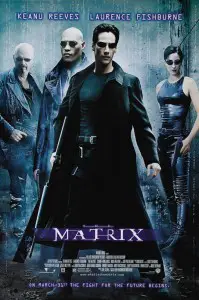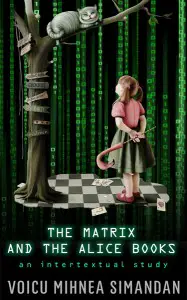 Directed by Andy and Larry Wachowski, The Matrix (1999) is considered to be “a cinematic fusion of philosophical, literary, and spiritual allusiveness” (Greydanus 2004). In 2000, the film was nominated for and won four of the prestigious Academy Awards prizes, given annually in the United States by the Academy of Motion Picture Arts and Sciences. The categories were: Best Editing; Best Effects and Visual Effects Editing; Best Effects and Visual Effects; and Best Sound. The Matrix also scored another 28 wins and 36 nominations from various film academies in the USA and abroad.
Directed by Andy and Larry Wachowski, The Matrix (1999) is considered to be “a cinematic fusion of philosophical, literary, and spiritual allusiveness” (Greydanus 2004). In 2000, the film was nominated for and won four of the prestigious Academy Awards prizes, given annually in the United States by the Academy of Motion Picture Arts and Sciences. The categories were: Best Editing; Best Effects and Visual Effects Editing; Best Effects and Visual Effects; and Best Sound. The Matrix also scored another 28 wins and 36 nominations from various film academies in the USA and abroad.
“Unfortunately, no one can be… told what the Matrix is… you have to see it for yourself” (Wachowski 1999), said Morpheus to Neo when the latter wanted to know what the Matrix is. Morpheus’s comment applies to the movie itself, which means that the reader of this article must have to have seen the film for at least once, in order to fully understand the issues discussed here. “The Matrix is everything, it is all around us. It is the world that has been pulled over your eyes to shield you from the truth” (Wachowski 1999).
There have been previous works that suggest the issues represented in The Matrix. In his 1975 novel Ignorance, Peter Unger discussed the possibility of an evil scientist who uses computers to entrap human minds in an elaborate simulation. Hilary Putnam took this idea even further in her novel entitled Reason, Truth, and History (1981) by proposing that human brains had been taken out of their bodies and subsequently become suspended and preserved in vats of chemicals. Then computers created the illusion that people were still living in the world. In Anarchy, State and Utopia (1975) by Robert Nozick, bodies are suspended in chemicals and are controlled by a machine that feeds humans electrical signals (Cline 2004).
In addition, two short stories are reminiscent of themes explored in The Matrix. The first short story (Cavagna 1999) is Wake Up to Thunder (1973) by Dean R. Koontz, in which humans serve a machine called Thunder. The second short story (Wu 1999) is I Have No Mouth and I Must Scream (1967) by Harlan Ellison, which might have been the inspiration for the scene where Agent Smith makes Neo’s mouth disappear.
The importance and the impact of The Matrix were succinctly stated in a review by Greydanus (2004): “Love it, hate it, or ignore it, there’s no getting around it: The Matrix phenomenon has become one of the most pervasive cultural touchstones of our day. It has been and continues to be referenced and expounded upon in university courses, philosophy books and essays, websites, everyday conversations, and even sermons and homilies.”
The Matrix is one of the most influential films of the sci-fi genre and, with its release in 1999, it opened a new era in the genre of cinematography. The story is centered on the notion that what we perceive as ‘reality’ is actually a computer generated interactive world, and raises the question of what ‘reality’ means (Yeffeth 2003: 52). After humans created AI, or Artificial Intelligence, some time in the 21st century, the machines and humans began a war, which the machines won. During the war the humans scorched the sky, thinking that this would deprive the machines of the only power source they had; i.e. the sun. However, the machines started harvesting and creating humans for the sole purpose of using them as batteries.
To keep humans under control as they harvested their energy, the machines created a computer program called the Matrix. In this program the humans live and interact with one another just like in the real world known before the human-machine war broke out. Except, the interaction is not real. The Matrix cannot control and keep track of all the thoughts and lives within it. As a result, freethinking humans, who feel that something is odd with the world they live in, become released from the Matrix by rebels. The rebels want to crack the framework that holds the Matrix in place, and free all of mankind. One such group of resistance fighters, led by their commander Morpheus, has been searching the Matrix for “the chosen one,” a saviour who will free the enslaved humans and destroy the Matrix.
In order to counteract and destroy the rebels, the machines have developed “agents,” shape-shifting sentinels, who are able to bend the rules of the Matrix, such as gravity, speed, sight, and strength. The purpose of these agents is to protect the Matrix and find the access codes to Zion, the last remaining free human city located close to the core of the earth, where it is still warm.
Many different locations serve as settings in The Matrix. The scenes that take place outside the Matrix are very strange and dark, but at the same time interesting and original (Gale 1999). The places in the Matrix have a Gothic-like atmosphere and combine different architectural styles, from modern to antique.
Morpheus thinks that he has found the saviour in the person of Mr. Thomas Anderson, a computer programmer working in a corporate cubicle, also known as Neo, an ingenious hacker who black-markets software. Although Neo is still plugged into the Matrix, he realizes that there is something wrong with the world. He is intrigued by a mysterious question, a question that surfaces repeatedly among hackers and in on-line chatrooms: “What is the Matrix?” Neo feels instinctively that this question is significant and tries to find the answer.
Morpheus thinks that he has found the saviour in the person of Mr. Thomas Anderson, a computer programmer working in a corporate cubicle, also known as Neo, an ingenious hacker who black-markets software. Although Neo is still plugged into the Matrix, he realizes that there is something wrong with the world. He is intrigued by a mysterious question, a question that surfaces repeatedly among hackers and in on-line chatrooms: “What is the Matrix?” Neo feels instinctively that this question is significant and tries to find the answer.
Upon agreeing to join Morpheus by taking the “red pill,” Neo is plucked from the Matrix in a spectacular rebirthing sequence that has both visual and metaphorical meanings. Neo then undergoes a series of training programs in which he is taught by Morpheus how to use his mind to bend the rules of existence within the Matrix. At the end of the film when Neo finally lets go of fear, doubt, and disbelief, he is able to see the Matrix as it really is, just a cascade of computerized digits.
Resources:
- Cavagna, C. (1999) The Matrix.
- Cline, A. (2004) The Matrix: Religion vs. Philosophy.
- Gale, D. (1999) The Matrix Review.
- Greydanus, S.D. (2003) The Matrix. Decent Films Guide.
- Wachowski A., and Larry Wachowski (1999) The Matrix: Script. Transcribed by Professor William Warner. Transcriptions Project. Department of English. University of California – Santa Barbara. Last updated April 2, 2002.
- Wu, F. (1999) Movie Review of The Matrix. Seeing is believing.
- Yeffeth, G. (ed.) (2003) Matrix: Stiinta, Filozofie si Religie. (Taking the Red Pill. Science, Philosophy and Religion in The Matrix). Ana-Maria Murariu (trasl.) Bucharest: Amaltea.
(Fragment from The Matrix and the Alice Books by Voicu Mihnea Simandan, p.36-39)
My intertextual study The Matrix and the Alice Books looks at the way Lewis Carroll’s Alice’s Adventures in Wonderland and Through the Looking-Glass have influenced some of the ideas put forth by Andy and Larry Wachowski. The book is now available as a Kindle ebook too.

